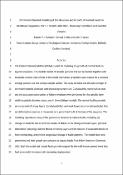Options
2D distinct element modeling of the structure and growth of normal faults in multilayer sequences : 1. Model calibration, boundary conditions, and selected results
Alternative Title
Two-dimensional distinct element modeling of the structure and growth of normal faults in multilayer sequences
Date Issued
2007
Date Available
2011-07-22T13:33:09Z
Abstract
The distinct element method is used for modeling the growth of normal faults in
layered sequences. The models consist of circular particles that can be bonded together with breakable cement. Size effects of the model mechanical properties were studied for a constant average particle size and various sample widths. The study revealed that the bulk strength of the model material decreases with increasing sample size. Consequently, numerical lab tests and the associated construction of failure envelopes were performed for the specific layer width to particle diameter ratios used in the multilayer models. The normal faulting models are composed of strong layers (bonded particles) and weak layers
(nonbonded particles) that are deformed in response to movement on a predefined
fault at the base of the sequence. The modeling reproduces many of the geometries
observed in natural faults, including (1) changes in fault dip due to different modes of failure in the strong and weak layers, (2) fault bifurcation (splaying), (3) the flexure of strong layers and the rotation of associated blocks to form normal drag, and (4) the progressive linkage of fault segments. The model fault zone geometries and their growth are compared to natural faults from Kilve foreshore (Somerset, United Kingdom). Both the model and natural faults provide support for the well-known general trend that fault zone width increases with increasing displacement.
layered sequences. The models consist of circular particles that can be bonded together with breakable cement. Size effects of the model mechanical properties were studied for a constant average particle size and various sample widths. The study revealed that the bulk strength of the model material decreases with increasing sample size. Consequently, numerical lab tests and the associated construction of failure envelopes were performed for the specific layer width to particle diameter ratios used in the multilayer models. The normal faulting models are composed of strong layers (bonded particles) and weak layers
(nonbonded particles) that are deformed in response to movement on a predefined
fault at the base of the sequence. The modeling reproduces many of the geometries
observed in natural faults, including (1) changes in fault dip due to different modes of failure in the strong and weak layers, (2) fault bifurcation (splaying), (3) the flexure of strong layers and the rotation of associated blocks to form normal drag, and (4) the progressive linkage of fault segments. The model fault zone geometries and their growth are compared to natural faults from Kilve foreshore (Somerset, United Kingdom). Both the model and natural faults provide support for the well-known general trend that fault zone width increases with increasing displacement.
Sponsorship
Irish Research Council for Science, Engineering and Technology
Other Sponsorship
Enterprise Ireland
Type of Material
Journal Article
Publisher
American Geophysical Union
Journal
Journal of Geophysical Research - Solid Earth
Volume
112
Issue
B10401
Copyright (Published Version)
2007 The American Geophysical Union
Subject – LCSH
Faults (Geology)--Mathematical models
Fault zones--Mathematical models
Rock deformation--Mathematical models
Web versions
Language
English
Status of Item
Peer reviewed
This item is made available under a Creative Commons License
File(s)
Loading...
Name
Schopfer_et_al_Part_1_JGR_2007_repository.pdf
Size
4.33 MB
Format
Adobe PDF
Checksum (MD5)
dcf5d12438bfa5e1ef09e2f6f92634f0
Owning collection